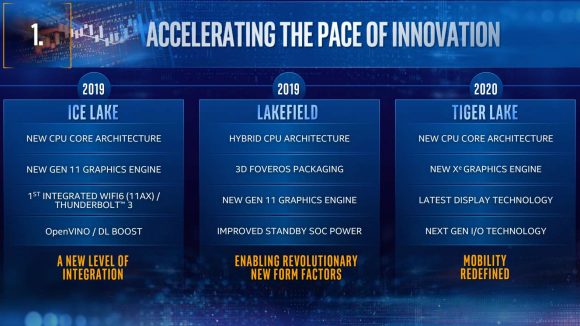An Intel Tiger Lake processor has been spotted in the wild lands of the SiSoft Sandra benchmarking database. Marking our first glance at this low-power architecture since it was first announced over at Intel’s recent investor meeting, Intel is promising Tiger Lake will bring “blistering graphics performance” thanks to the Intel Xe graphics engine at its heart.
But swiftly lower your expectations for the time being, as the entry in question is only a dual-core chip, running at a rather palty 1.8GHz boost and 1.5GHz base. Okay, not such a promising start but it’s early days for the graphics-led chip. Intel’s not touting Tiger Lake until 2020, following its first foray into 10nm volume production with Intel Ice Lake chips this June.
The “Genuine Intel CPU 0000” chip, recorded on the Intel Tiger Lake platform, will also be fitted with 256KB of L2 cache per core and 2MB of L3 cache. While the TDP has not been specified, it is likely much, much lower than the usual desktop TDP of 65W – somewhere in the region of 15W or less.
And while CPU power isn’t much to write home about, graphical capability will be the driving force behind Tiger Lake’s success. Intel’s integrated graphics have so far been rather lacklustre, just about scrapping by the bare minimum for some low-impact competitive titles such as CS:GO or DOTA II. But that’s all set to change with Intel’s upcoming architectures.
Starting with Gen 11, Intel is set to more than double the number of Execution Units (EUs) per chip, resulting in a rather considerable performance bump. Following that, Gen 12 graphics, powered by Intel’s Xe graphics architecture, will further increase on-chip graphics capabilities.
We’ll also see Intel venture into discrete graphics with its own graphics card built upon Intel Xe in 2020. Hoping to take on AMD and Nvidia in gaming, Intel has high hopes for its foray into dGPUs.
“It’s got the same IP, the basis of that discrete graphics engine that we talked about earlier, that Xe for graphics,” Gregory Bryant says during the Intel investor meeting. “That engine is built into Gen 12 with Tiger Lake, so we’re going to see blistering graphics performance for even more gaming, content creation, and productivity; usage models and commercial; and we’re excited about the new range of devices that will be on Tiger Lake.
“And I can say, sitting here today, we have Tiger Lake silicon back at Intel, we have already booted Windows and Chrome, and we’re making great progress on Tiger Lake for 2020.”
That’s sure to be the same early Tiger Lake engineering samples we’re now seeing appear in SiSoft Sandra.
Intel still has a rather dominant market share in the mobile segment, which could be a strong entry point for Intel Xe graphics come 2020. But the company is struggling to keep apace with TSMC – and by extension, AMD with Zen 2 and beyond – which means Ice Lake, Lakefield, and Tiger Lake will need to be wholly successful and reinvigorating ventures in order for Intel to look at all convincing in years to come. There’s a long way to go from that dual-core, 1.8GHz Tiger Lake chip, that’s for sure.

